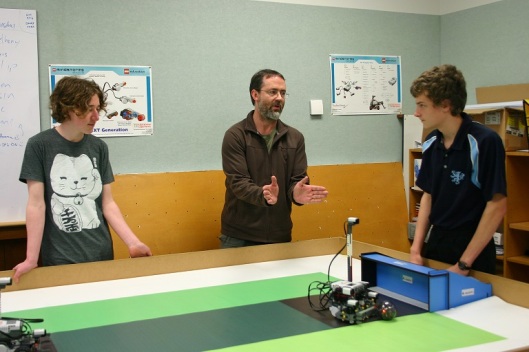Tags
1960s, 1970s, 1980s, chemistry, computer science, geology, library, mathematics, physics, technology
This year is the 50th anniversary of two significant university buildings. Ironically, the one originally called ‘interim’ is still here, while the other has gone!

The northern side of the new Library/Arts Building in 1965. Image courtesy of the Hocken Collections, S13-217g.
On 7 April 1965 the new Library/Arts Building was officially opened by the Minister of Education with much fanfare (complete with a student protest about inadequate government funding for university staff and facilities). The library, which had been taking up more and more space in the old clocktower building, now had a spacious new home, and there was also room for some of the arts and commerce departments. Those departments later moved out into other new buildings, allowing the library to expand. But as the university grew and grew, the library space became inadequate. Since the building’s design did not allow for any additions, some of the collections were moved into other spaces. Eventually the central library building was replaced by the current Information Services Building, completed in 2001.
Not far away from the library is the other 1965 building, now known as the Information Technology Services Building. It started out as the Interim Science Building. The word interim did not refer to the building, but to its usage – it was to provide temporary additional space for the physical sciences until their large new buildings were completed in the 1970s. There was a lot less fanfare over this building. I haven’t yet uncovered any evidence that it even had an official opening – its residents simply moved in and started using it in September 1965.
Though the numbers seem small by today’s standards, the university was growing rapidly in this period, making the old buildings woefully inadequate. The student roll jumped from 2000 in 1955 to 3700 in 1965; by 1975 it had reached 6300. As the Vice-Chancellor Arthur Beacham commented in 1964 when plans for the interim building were announced, it meant the university could avoid restricting entry into the physical sciences, whose labs were cramped into every attic and basement available.
The key feature of the Interim Science Building – a two-storey light steel-frame construction – was that it could be built quickly. The design, by Auckland architects Beatson, Rix-Trott, Carter & Co., had already been used for buildings at Auckland and Massey universities, though of course the foundations had to be customised for the site. The site was a particularly interesting one. With no space for a long building readily available around campus, it was built to span the Water of Leith. Once government funding was approved in October 1964, the University of Otago accepted a tender from Dunedin building firm Mitchell Brothers and, true to schedule, science departments moved in just under a year later.

The Information Technology Services Building, formerly the Interim Science Building, photographed by Ali Clarke, March 2015.
For several years the Interim Science Building provided extra laboratory space for the geology, physics and chemistry departments. In the 1970s, as the large new Science I, II and III buildings were completed, those departments moved out. The initial plan was for the building to then become available for expansion of the School of Home Science, but nobody had foreseen the ever-growing needs of another original occupant of the building, the university’s computing services.
The timing of the Interim Science Building construction was providential for the beginnings of computing at Otago. Space was reserved for installation of an IBM 360/30 early in 1966; this was run by the mathematics department. The large space under the building, where it crossed the Leith, proved convenient for the running of all the cables needed for the computer and its powerful air conditioning system. There were some disadvantages though. Brian Cox, the mathematician who became Otago’s first computer scientist, recalls that the puzzle of frequent false fire alarms was solved when they discovered that waterblasting under the building had accidentally stripped the insulation off all the wiring! Rumour has it that people waiting for the computer to work through a program sometimes passed the time by fishing out the window.
Early computers were very large in size, if not in data capabilities – Otago’s first IBM had 16KB of memory! A new computer, installed in 1973, filled half the ground floor of the Interim Sciences Building. Later computers were smaller, but there were many more of them, together with a growing staff to manage computer services all around campus, train users and carry out academic research and teaching in computer science. By the mid-1980s computing had taken over the entire building, which was renamed the Computing Services Building to reflect that. The building design had proved flexible – “hardly any of its internal walls are the originals”, commented the staff newsletter in 1986. Later, when Computing Services became Information Technology Services, the building was renamed the Information Technology Services Building.
Do you have any memories to share of the Interim Sciences Building? And do you know of any early photos of the building? The only ones I’ve located so far are in newspaper clippings. It’s hard to photograph these days because the trees have grown so much!










